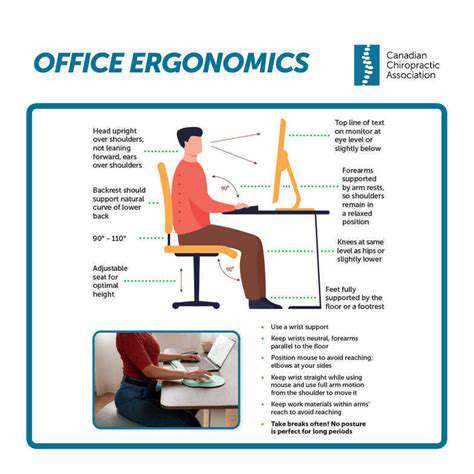How to Improve Your Sitting Posture at a Computer
Ergonomics Essentials for a Healthier Workstation

Ergonomic Posture and Seating
Maintaining proper posture is crucial for overall well-being, especially when working at a desk for extended periods. Poor posture can lead to a multitude of musculoskeletal issues, ranging from neck pain and backaches to headaches and carpal tunnel syndrome. Understanding the principles of ergonomic posture is key to minimizing these risks. A good posture involves keeping your back straight, shoulders relaxed, and your feet flat on the floor. This alignment distributes weight evenly, reducing strain on your spine and other supporting muscles. Proper seating plays a significant role in maintaining this posture. An adjustable chair with lumbar support is essential for providing adequate back support and promoting natural spinal curves.
Choosing the right chair is paramount. It should allow you to maintain a neutral spine alignment. Features like adjustable height, armrests, and lumbar support are vital for tailoring the chair to your specific body needs. A chair that's too high or too low can put undue stress on your back and neck, potentially causing long-term discomfort. Ensure that your feet are flat on the floor and that your knees are bent at a 90-degree angle when seated. These simple adjustments can significantly improve your posture and comfort level throughout the workday.
Screen Placement and Keyboard Position
Proper screen placement is crucial for preventing eye strain and neck pain. The top of the screen should be at or slightly below eye level. This minimizes the need to constantly look up or down, which can lead to neck discomfort. Avoid glare and reflections by positioning your screen away from windows and using appropriate lighting to reduce strain on your eyes.
The keyboard should be positioned directly in front of you, allowing for a natural wrist position. Avoid awkward bends or stretches to prevent carpal tunnel syndrome and repetitive strain injuries. Adjust the keyboard's height so that your wrists are straight when typing. Proper keyboard positioning reduces strain on your wrists and hands, preventing long-term discomfort. This also prevents the risk of repetitive strain injuries.
Ensure that your elbows are bent at approximately a 90-degree angle when using the keyboard. This helps maintain a neutral posture and reduces tension in your shoulders and upper back. A properly positioned keyboard and mouse will contribute significantly to a more comfortable and productive work environment.
Workstation Design and Organization
A well-organized workstation promotes efficiency and reduces stress on the body. Keeping frequently used items within easy reach minimizes unnecessary movements and prevents straining to access them. This minimizes the physical strain on your body. A cluttered workspace can lead to unnecessary movements, causing discomfort and fatigue. A well-organized space promotes a more focused and productive work environment.
Consider using a document holder to prop up papers or documents at the optimal reading height, helping to maintain a neutral posture while working with documents. This prevents neck and back strain. Maintaining a clean and organized workspace contributes to a healthy and productive work environment. Proper workstation design ensures that you can perform tasks comfortably and efficiently. This will reduce the risk of developing musculoskeletal problems over time.
Consider using a monitor stand to raise your monitor to the right height. This prevents eye strain and neck discomfort. Having necessary items organized within reach minimizes unnecessary movements, reducing fatigue and discomfort. A properly designed workstation reduces the risk of musculoskeletal problems over time.
Practical Tips for Maintaining Good Posture
Understanding the Importance of Good Posture
Maintaining good posture isn't just about looking good; it's crucial for overall health and well-being. Proper posture supports your spine, reducing strain on muscles, ligaments, and joints. This, in turn, can alleviate back pain, headaches, and other musculoskeletal issues, improving your quality of life significantly. By understanding the impact of posture on your body, you're better equipped to make conscious choices that promote a healthier lifestyle.
Poor posture can lead to a cascade of problems, impacting everything from your physical comfort to your energy levels. It's a critical component of long-term health and well-being, and something we should all be mindful of throughout our daily routines.
Identifying Common Posture Problems
Slouching, hunching, and rounded shoulders are just a few examples of common posture problems that can arise from prolonged sitting or incorrect positioning. Recognizing these issues is the first step towards correction. Identifying these problems allows us to focus on the specific areas needing improvement and tailor our posture-correcting strategies accordingly.
Understanding the subtle differences between good and bad posture is key to making conscious choices to improve your overall well-being. This includes paying attention to the alignment of your head, shoulders, and hips.
Ergonomic Adjustments for Your Workspace
Your workspace plays a significant role in your posture. Adjusting your chair, desk, and monitor height to suit your body type is essential for maintaining good posture throughout the workday. An ergonomically sound setup reduces strain on your muscles and joints, making work more comfortable and productive. Properly positioned items like keyboards and mice can greatly impact your posture while reducing repetitive stress injuries.
Consider an adjustable chair with lumbar support, a monitor positioned at eye level, and a keyboard and mouse that are easily accessible without straining your wrists. These small adjustments can make a big difference in your overall comfort and posture.
Incorporating Movement Breaks
Sitting for extended periods can negatively impact posture, leading to stiffness and muscle fatigue. Regular movement breaks are vital for maintaining good posture throughout the day. Even short walks around the office or simple stretches can significantly improve posture and reduce the risk of developing postural issues over time.
Regular movement breaks are essential for circulation, which helps prevent stiffness and muscle tension. This promotes a more balanced posture by preventing prolonged periods of inactivity. Incorporate these breaks into your schedule to ensure you maintain good posture throughout the workday.
Posture-Correcting Exercises
Gentle stretches and exercises can help strengthen the muscles that support good posture. These exercises can be performed at your desk or during breaks, and they don't require special equipment. These exercises are designed to work on the problem areas of the back, neck and shoulders, so you can alleviate pain and improve posture.
The Role of Proper Sleeping Habits
Your sleep environment and posture during sleep also impact your overall posture. Using pillows that support your neck and back, and avoiding sleeping in awkward positions, can contribute to better posture throughout the day. Consistency in your sleep routine and environment is a critical component to improve posture.
A good night's sleep allows your muscles to recover and repair, setting you up for a day of improved posture. A supportive sleep environment is just as important as a supportive workspace.
Mindful Awareness and Habit Formation
Developing mindful awareness of your posture throughout the day is a crucial step toward long-term improvement. Be conscious of how you sit, stand, and walk, and make adjustments as needed. Making these small changes a habit over time leads to significant improvements in your overall posture and health.
Regularly practicing these tips can help you form positive habits that promote good posture. It's a journey, not a destination, so be patient with yourself and celebrate your progress along the way.
Preventing and Addressing Common Posture Issues
Identifying Common Posture Problems
Poor posture can manifest in various ways, impacting not only your physical comfort but also your overall well-being. Identifying these issues is crucial for effective intervention. Common problems include rounded shoulders, a forward head posture, and a swayback or excessively arched lower back. These postural deviations can lead to muscle imbalances, pain, and long-term health concerns. Understanding the subtle signs of these issues is the first step towards improvement.
Often, these problems develop gradually, making them difficult to notice initially. Regular self-assessment and awareness of your body's alignment, especially during prolonged sitting periods, are essential for early detection. Professional guidance, such as consultation with a physical therapist, can provide a deeper understanding of specific postural issues and personalized solutions.
The Impact of Prolonged Sitting
Prolonged sitting, a hallmark of modern lifestyles, can significantly impact posture. The lack of regular movement and muscular engagement during extended sedentary periods often contributes to postural distortions. Our bodies are designed for movement, and when we restrict ourselves to prolonged stillness, it can lead to muscle fatigue, stiffness, and even pain.
This prolonged inactivity can also affect circulation and metabolic function. Recognizing the detrimental effects of prolonged sitting is the first step towards implementing strategies to counteract these negative impacts. Integrating regular movement breaks and active postures into your daily routine can significantly mitigate these issues.
Ergonomic Considerations for a Healthy Workspace
Ergonomics plays a vital role in maintaining good posture, especially in the context of a work environment. Creating a workspace that supports healthy posture involves mindful consideration of chair height, desk setup, and monitor placement. Adjusting these elements to ensure proper alignment can significantly reduce stress on the spine and surrounding muscles.
An ergonomic chair that supports the natural curves of your spine and allows for adjustable height and lumbar support is crucial. A properly positioned monitor, at or slightly below eye level, minimizes strain on the neck and shoulders. A well-organized desk layout, with frequently used items within easy reach, prevents unnecessary reaching and twisting, further enhancing posture.
Incorporating Movement and Stretching
Regular movement and stretching are essential for maintaining good posture and preventing its deterioration. Simple exercises, such as shoulder rolls, neck stretches, and back extensions, can help maintain flexibility and strength in the muscles that support good posture. Incorporating these exercises into your daily routine can help alleviate muscle stiffness and improve overall mobility.
Taking short breaks throughout the workday to stand up, walk around, and perform stretching exercises can significantly benefit your posture. These brief periods of movement can help to counteract the negative effects of prolonged sitting and improve circulation. Regular physical activity outside of work, such as walking, swimming, or yoga, further reinforces the benefits of movement for maintaining good posture and overall well-being.
Seeking Professional Guidance
If you experience persistent posture-related pain or discomfort, seeking professional guidance from a physical therapist or other healthcare provider is crucial. A qualified professional can assess your specific posture concerns, identify any underlying issues, and develop a personalized treatment plan. This plan might involve specific exercises, stretches, or recommendations for ergonomic adjustments.
Don't hesitate to consult a healthcare professional if you're experiencing chronic pain or discomfort related to posture. A professional evaluation can provide valuable insights and tailored solutions for addressing your specific needs. Early intervention can help prevent the progression of posture-related problems and promote long-term health and well-being.
Read more about How to Improve Your Sitting Posture at a Computer
Hot Recommendations
- How to Fix Cakey Foundation
- Best Eye Creams for Wrinkles
- The Science Behind Ceramides in Skincare
- How to Fix a Broken Nail Quickly
- How to Improve Your Listening Skills for Better Communication
- How to Use Body Language to Build Trust
- The Role of Scent in Personal Image
- Best Affordable Vitamin C Serums [2025]
- Best Affordable Eyeshadow Palettes [2025]
- Guide to Caring for High Porosity Hair






![Review: [Specific Plus Size Clothing Brand] Fit and Style](/static/images/29/2025-05/ValueforMoney3AABalancedApproach.jpg)




